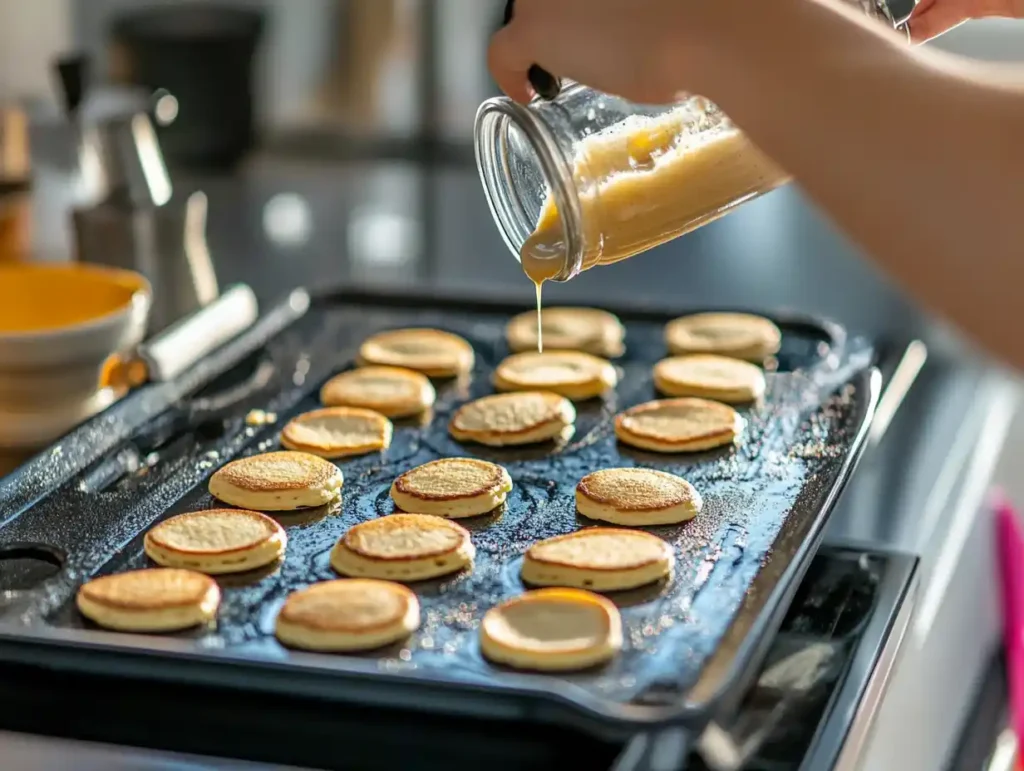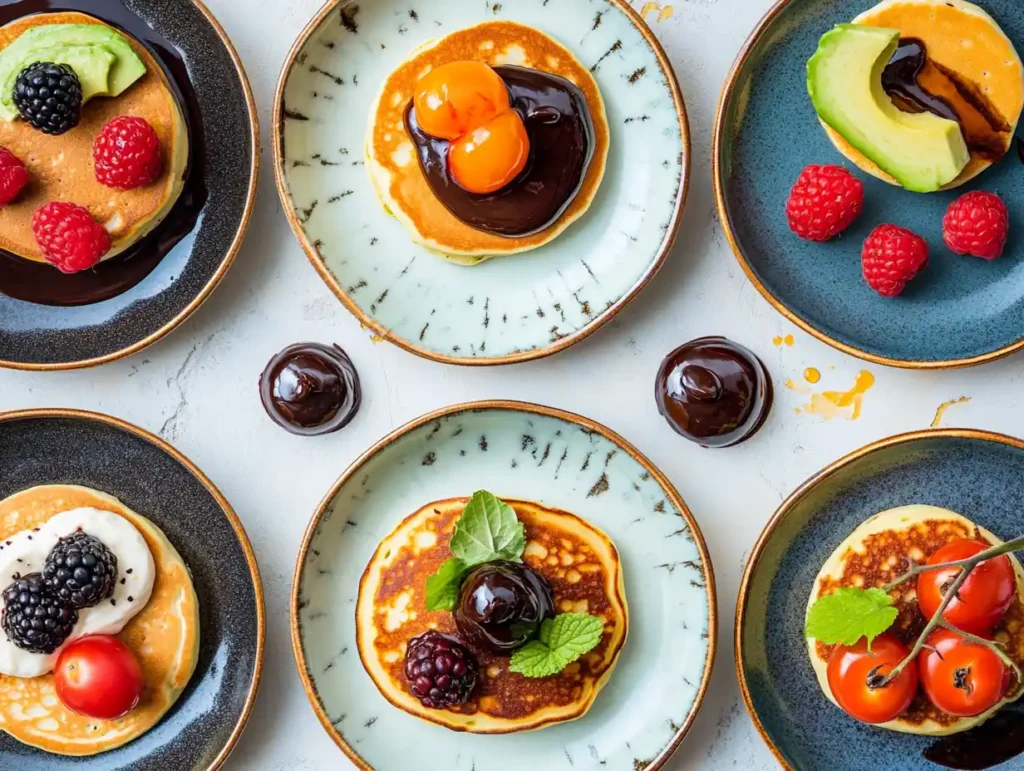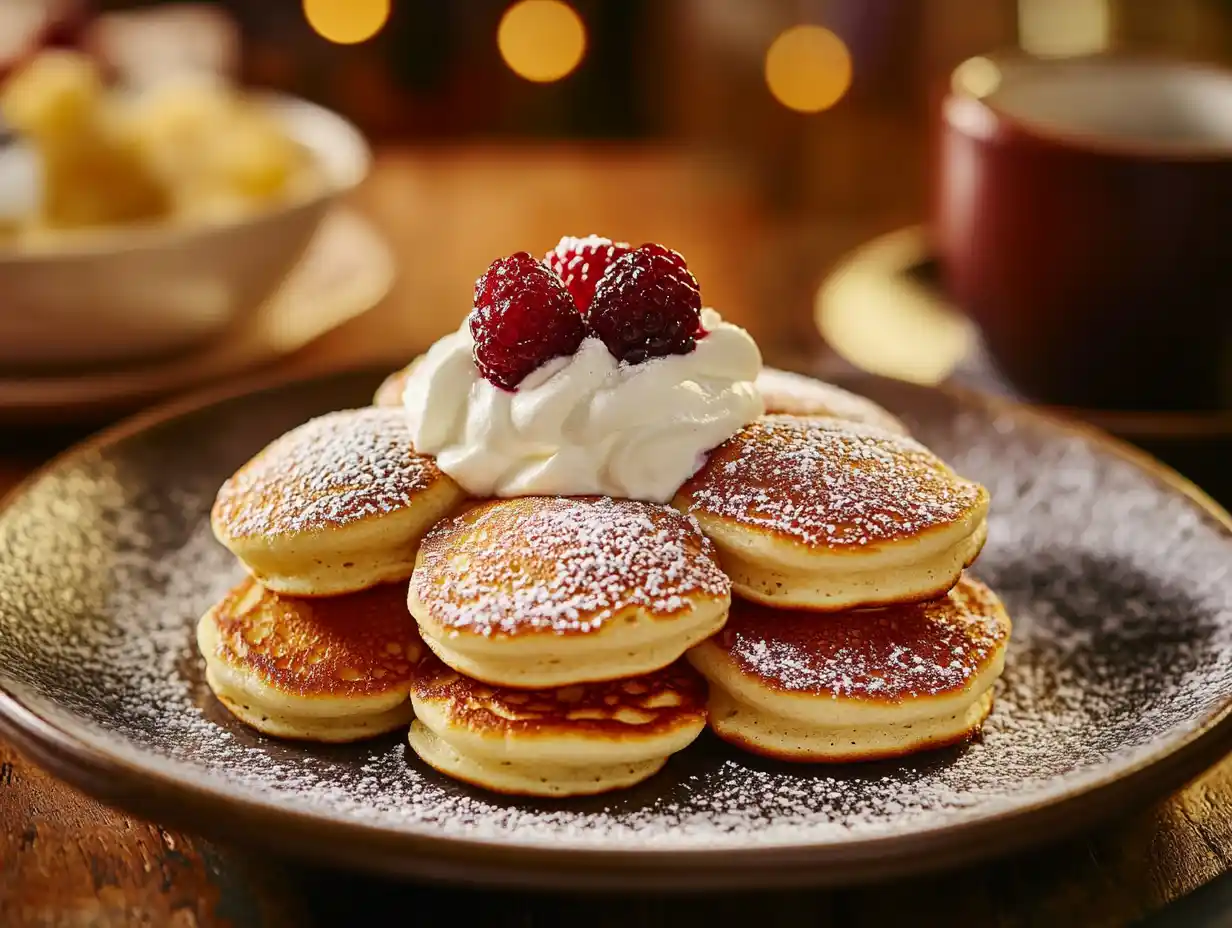Introduction
Mini pancakes have taken the culinary world by storm, offering a delightful twist to traditional pancakes. These bite-sized treats are fun, versatile, and perfect for any occasion—from breakfast and brunch to snacks and desserts. Their small size not only makes them visually appealing but also practical for portion control and creative serving ideas.
But what is another name for mini pancakes? Interestingly, different regions and cultures have unique terms and recipes for these fluffy delights. For instance, in the Netherlands, they’re called poffertjes, while Americans often refer to them as silver dollar pancakes due to their coin-like size.
Understanding the different names for mini pancakes opens the door to exploring diverse recipes, cooking techniques, and cultural traditions. Whether you’re looking to expand your culinary repertoire or impress guests with an international twist, this guide has you covered.
In this article, we’ll uncover the various names for mini pancakes worldwide, discuss their rich history, and share tips for making the perfect batch. By the end, you’ll not only know what to call them but also how to create these delicious treats at home.
Different Names for Mini Pancakes Around the World
Mini pancakes may look similar worldwide, but their names and preparation methods differ depending on cultural influences. Let’s take a closer look at some popular variations:
Silver Dollar Pancakes (USA)
In the United States, mini pancakes are most commonly known as silver dollar pancakes. The name comes from their size, which resembles that of a silver dollar coin—about 2–3 inches in diameter.
These pancakes are typically served stacked high, drizzled with syrup, and topped with fruits, nuts, or whipped cream. Their small size makes them perfect for quick breakfasts, children’s meals, or side dishes alongside eggs and bacon.
Silver dollar pancakes are often found in diners, breakfast chains, and homemade brunch spreads. They’re made using the same batter as regular pancakes but cooked in smaller portions to give them their signature miniature look.
Poffertjes (Netherlands)
Poffertjes are fluffy, sweet mini pancakes that originated in the Netherlands. They’re made with a yeast-based batter, which gives them a slightly airy texture, and are traditionally cooked in a special pan with shallow, round molds.
These Dutch delights are often served at fairs and street markets, dusted with powdered sugar and topped with butter. Their soft, pillowy texture pairs perfectly with syrups, chocolate sauces, or even fresh fruit.
Poffertjes hold cultural significance in the Netherlands, where they are enjoyed during celebrations and holidays. They’re also commonly paired with warm drinks, making them a cozy treat for cold weather.
Oladyi (Russia)
In Russia, mini pancakes are called oladyi. Unlike other versions, oladyi are thicker and denser, resembling fritters more than traditional pancakes. They’re often made with kefir or buttermilk, giving them a tangy flavor.
Oladyi are typically served with sour cream, jam, honey, or berries, making them a versatile dish that works for both sweet and savory cravings. Their thicker texture makes them hearty and filling, ideal for breakfast or afternoon tea.
Hotcakes (Latin America & Asia)
In Latin America and parts of Asia, mini pancakes are frequently referred to as hotcakes. While similar in preparation to American pancakes, they’re usually smaller and slightly denser.
Hotcakes are a popular street food, often sold by vendors with toppings like condensed milk, dulce de leche, or fresh fruits. They can also be stacked and eaten with syrup, butter, or chocolate sauce for a sweeter flavor profile.
In Japan, a specific version called mini soufflé pancakes has gained popularity for its light and airy texture. These are often served in stacks with elaborate toppings, appealing to both the eyes and the palate.
Blinis (Eastern Europe)
Although slightly different, blinis in Eastern Europe are often associated with mini pancakes. Unlike the sweeter varieties, blinis are typically savory and made with buckwheat flour.
They are served as appetizers or canapés, topped with sour cream, smoked salmon, or caviar, making them a luxurious treat for special occasions.
Other Regional Names
- Scotch Pancakes (Scotland): Also known as drop scones, these are slightly thicker than American pancakes and often enjoyed with butter and jam.
- Pikelets (Australia & New Zealand): Similar to crumpets, pikelets are soft, fluffy, and slightly spongy, perfect for afternoon tea.
- Kaiserschmarrn (Austria): Although technically shredded pancakes, these are made in bite-sized portions, often served with fruits or powdered sugar.
Cultural Appeal of Mini Pancakes
The variety of names for mini pancakes highlights their universal appeal. Whether you’re savoring poffertjes at a Dutch festival or enjoying silver dollar pancakes at an American diner, each version brings a unique taste and tradition to the table.
Mini pancakes are more than just a breakfast food—they’re a celebration of culinary creativity. They can be customized with endless toppings, fillings, and flavors to suit any occasion.
In the next sections, we’ll dive into the fascinating origins of mini pancakes, explore their nutritional benefits, and provide tips for making the perfect batch at home.
Origins and History of Mini Pancakes
Mini pancakes trace their roots to ancient civilizations, where people experimented with simple batter recipes made from flour, water, and eggs. These early pancakes cooked on hot stones or griddles, evolving over centuries into the beloved versions we know today.
Ancient Pancake Traditions
Historians believe the Greeks and Romans enjoyed early forms of pancakes. They mixed wheat flour, olive oil, honey, and milk to create flat cakes, often sweetened with fruits. These early pancakes resembled modern variations and inspired many regional adaptations.
Cultural Significance Around the World
- Netherlands: Dutch bakers introduced poffertjes in the 18th century. They used yeast and buckwheat flour to create fluffy, sweet treats, perfect for festivals and celebrations.
- United States: American cooks popularized silver dollar pancakes in the early 1900s, serving them as breakfast favorites in diners and households.
- Russia: Russians developed oladyi, thicker and denser pancakes, to complement traditional dishes like sour cream and jam.
- Japan: Japanese chefs modernized mini pancakes by creating soufflé-style versions, blending art and flavor for elegant desserts.
These adaptations showcase how mini pancakes reflect cultural creativity while preserving their historical charm.
How to Make Mini Pancakes

Mini pancakes combine simplicity with endless possibilities. Follow these steps to create light, fluffy pancakes that impress everyone at the table.
Ingredients and Tools Needed
You can prepare mini pancakes with a few basic ingredients.
- Flour: All-purpose flour works best, but whole wheat or almond flour adds a healthier twist.
- Eggs: Eggs bind the batter and create a soft texture.
- Milk: Whole milk delivers richness, but almond, oat, or soy milk suits dairy-free diets.
- Sugar: A small amount sweetens the batter without overpowering toppings.
- Baking Powder: Baking powder helps pancakes rise, creating a light, fluffy result.
- Butter or Oil: Butter adds flavor, while oil prevents sticking.
Optional Add-Ins:
- Vanilla extract for sweetness.
- Cinnamon or nutmeg for warmth.
- Mashed bananas or chocolate chips for flavor twists.
Tools You Need:
- Mixing bowl and whisk.
- Non-stick griddle or skillet.
- Small scoop or spoon for portioning batter.
- Spatula for flipping pancakes.
Step-by-Step Recipe for Classic Mini Pancakes
1: Prepare the Batter
Whisk the flour, baking powder, sugar, and salt in a large bowl. In another bowl, beat the eggs, milk, and melted butter until smooth. Gradually combine the wet and dry ingredients, stirring gently until the batter turns smooth. Avoid over-mixing, as it can make the pancakes dense.
2: Preheat the Pan
Heat a non-stick griddle or skillet over medium heat. Lightly grease it with butter or oil to prevent sticking.
3: Cook the Pancakes
Scoop small dollops of batter onto the pan using a teaspoon or a squeeze bottle for uniform size. Cook each pancake until bubbles form on the surface, then flip and cook the other side until golden brown.
4: Serve and Enjoy
Stack the pancakes on a plate, drizzle syrup, and add fruits, nuts, or whipped cream for a finishing touch.
Creative Variations of Mini Pancakes
Vegan Mini Pancakes
- Replace eggs with mashed bananas or applesauce.
- Use almond or oat milk instead of dairy.
- Add chia seeds or flaxseed meal for extra nutrition.
Gluten-Free Mini Pancakes
- Substitute all-purpose flour with almond or oat flour.
- Include a pinch of xanthan gum for better texture.
Stuffed Mini Pancakes
- Place chocolate chips, Nutella, or berries in the batter before flipping.
- Cook until the filling melts, creating a delicious surprise in every bite.
Savory Mini Pancakes
- Omit sugar and add shredded cheese, herbs, or chopped vegetables.
- Serve with sour cream, salsa, or avocado for a unique twist.
Pro Tips for Perfect Mini Pancakes
Preheat Properly
Always preheat the pan for even cooking. Medium heat prevents burning while keeping the pancakes fluffy.
Measure Batter Evenly
Use a teaspoon, small scoop, or squeeze bottle to create uniform pancakes. Consistency ensures they cook at the same time.
Flip at the Right Moment
Watch for bubbles on the surface before flipping. This timing guarantees a golden brown finish.
Keep Pancakes Warm
Place cooked pancakes in a warm oven to keep them soft and ready to serve. Avoid stacking too early to prevent sogginess.
Mini pancakes prove that small treats can deliver big flavor. With just a few ingredients and simple steps, you can create crowd-pleasing dishes for any occasion.
Nutritional Benefits of Mini Pancakes
Mini pancakes deliver flavor and fun in every bite, but their nutritional value depends on ingredients and preparation. By making smart choices, you can enjoy these treats without guilt.
Portion Control and Calories
One of the biggest advantages of mini pancakes is their small size, which naturally encourages portion control. Instead of eating a full stack of large pancakes, you can savor just a few bite-sized pieces while satisfying your craving.
Mini pancakes typically contain fewer calories per piece compared to traditional pancakes, especially when made with lighter ingredients like almond or oat flour. Their compact form also makes them ideal for sampling different toppings without overindulging.
For example:
- 3 silver dollar pancakes with syrup and fruit provide about 150–200 calories, depending on toppings.
- Poffertjes, served with butter and powdered sugar, may range from 250–300 calories per serving, offering a rich but manageable indulgence.
Healthy Ingredient Alternatives
To boost nutrition, many people swap out traditional ingredients for healthier options:
- Flour Alternatives: Use whole wheat, almond, or oat flour for added fiber and nutrients.
- Milk Options: Replace regular milk with almond, soy, or oat milk for a dairy-free alternative.
- Sweeteners: Swap refined sugar for honey, maple syrup, or mashed bananas to cut processed sugar intake.
- Add-Ins for Protein: Incorporate Greek yogurt, protein powder, or chia seeds to enhance protein levels.
These simple swaps add nutrients without compromising taste, making mini pancakes suitable for health-conscious eaters.
Balanced Toppings for Healthier Options
The toppings you choose can transform mini pancakes into a balanced meal or snack. Instead of sugary syrups, try:
- Fresh Fruits: Blueberries, strawberries, bananas, or sliced peaches add natural sweetness and vitamins.
- Nut Butters: Almond or peanut butter delivers healthy fats and protein.
- Yogurt or Cottage Cheese: These creamy toppings pair well with honey or nuts, creating a protein-packed option.
- Savory Options: For a twist, top mini pancakes with smoked salmon, avocado, or poached eggs for a savory delight.
Mini pancakes can easily fit into a balanced diet by combining complex carbohydrates, healthy fats, and protein.
Mini Pancakes in Modern Food Trends
Have surged in popularity, thanks to social media and viral food trends. Their size, versatility, and visual appeal make them ideal for creative presentations and fun recipes.
The Rise of Mini Pancake Cereal
One of the biggest trends to emerge recently is mini pancake cereal. This idea started on platforms like TikTok, where food influencers showcased tiny pancakes served in bowls like cereal.
To create pancake cereal:
- Pipe tiny drops of batter onto a pan and cook until golden brown.
- Transfer them into a bowl and top with milk, syrup, or fruits.
- Add whipped cream or sprinkles for extra flair.
The trend combines novelty with flavor, making it popular with kids and adults alike. It’s also a great way to experiment with colors, flavors, and toppings, turning breakfast into an interactive experience.
Social Media Influence and Creative Presentations
Mini pancakes have dominated social media platforms like Instagram and Pinterest, where visually appealing dishes thrive. Food bloggers and influencers frequently experiment with creative designs, stacking pancakes into towers, arranging them into patterns, or turning them into bite-sized skewers for parties.
Some popular ideas include:
- Mini Pancake Skewers: Alternate layers of pancakes, fruits, and marshmallows for a fun appetizer.
- Layered Desserts: Stack pancakes with whipped cream and berries for a parfait-like dessert.
- Themed Designs: Decorate pancakes to match holidays or celebrations, such as hearts for Valentine’s Day or pumpkins for Halloween.
These ideas inspire home cooks and chefs to think outside the box, adding a playful touch to traditional recipes.
Instagram-Worthy Plating Ideas
The visual appeal of mini pancakes makes them perfect for eye-catching presentations. Try these plating tips:
- Stacks and Towers: Create mini towers and drizzle syrup or chocolate sauce for an elegant look.
- Bento Box Pancakes: Arrange pancakes with fruits, nuts, and spreads in compartmentalized lunch boxes for a balanced snack.
- Cup Pancakes: Serve mini pancakes in small cups with layers of yogurt, fruits, and granola for a parfait-style treat.
- Board Displays: Make a pancake charcuterie board with various toppings, spreads, and fruits, ideal for brunch gatherings.
These presentations aren’t just visually appealing—they also invite people to customize their plates, adding to the fun.
Mini pancakes have become more than just a breakfast option—they represent creativity, innovation, and fun in modern food culture. Whether served as cereal, skewers, or layered desserts, they continue to inspire home cooks and food enthusiasts worldwide.
FAQs About Mini Pancakes

Mini pancakes spark curiosity among food lovers. Here are some frequently asked questions that provide insights into their names, preparation, and variations.
What are mini pancakes called in different regions?
Mini pancakes go by many names worldwide. In the United States, people call them silver dollar pancakes because of their size. The Netherlands boasts poffertjes, which use yeast for extra fluffiness. Russia offers oladyi, thicker pancakes served with sour cream or jam. In Japan, soufflé-style pancakes have become trendy for their airy texture. Meanwhile, Latin America and Asia often refer to them as hotcakes, served with sweet toppings like condensed milk or syrup.
Are blinis and mini pancakes the same?
Not exactly. Blinis, a staple in Eastern European cuisine, tend to be savory and made with buckwheat flour. People often serve them as appetizers with toppings like smoked salmon or caviar. Mini pancakes, on the other hand, usually taste sweet and rely on traditional pancake batter.
Can you make mini pancakes without eggs?
Yes, you can create egg-free mini pancakes easily. Replace eggs with:
- Mashed bananas for natural sweetness.
- Applesauce to add moisture.
- Flaxseed or chia seed mixtures for binding properties.
These alternatives keep the pancakes light and flavorful while accommodating dietary preferences.
What’s the best pan for making mini pancakes?
A non-stick griddle works best for mini pancakes because it prevents sticking and distributes heat evenly. If you want perfect, round shapes, invest in a poffertjes pan with circular molds. For added convenience, use a piping bag or squeeze bottle to control batter size.
How do you stop mini pancakes from sticking?
To prevent sticking, always:
- Preheat the pan properly. Warm it up before adding batter.
- Grease lightly. Use butter, oil, or cooking spray for a non-stick surface.
- Avoid high heat. Medium heat cooks pancakes evenly without burning.
- Wipe the pan. Clean any leftover batter between batches to avoid sticking.
Following these steps guarantees a smooth cooking process.
Are mini pancakes healthier than regular pancakes?
Mini pancakes can be healthier, depending on ingredients and toppings. Their smaller size promotes portion control, reducing calorie intake. You can also:
- Swap white flour for whole wheat or oat flour to add fiber.
- Cut sugar by using natural sweeteners like honey or mashed bananas.
- Boost protein with Greek yogurt, nuts, or seeds.
Pair mini pancakes with fruits, nut butters, or yogurt to create a balanced and nutritious meal.
Can I make mini pancakes ahead of time?
Absolutely! Mini pancakes store well and reheat quickly. After cooking:
- Cool them completely.
- Store in airtight containers. Keep them in the refrigerator for up to 3 days or freeze for 1 month.
- Reheat in minutes. Use a toaster oven, skillet, or microwave for quick warm-ups.
Preparing mini pancakes in advance makes them a convenient option for busy mornings.
Conclusion
Mini pancakes, no matter what you call them—poffertjes, silver dollar pancakes, or oladyi—continue to captivate food lovers worldwide. Their bite-sized charm, versatility, and ease of preparation make them perfect for any occasion, whether it’s a cozy breakfast at home, a festive brunch, or a creative dessert table at parties.
From their ancient origins to modern-day trends like mini pancake cereal, these fluffy treats have evolved while retaining their timeless appeal. Their adaptability allows you to experiment with ingredients, flavors, and toppings, satisfying every palate and dietary preference. Whether you prefer classic recipes, gluten-free options, or savory twists, mini pancakes promise endless possibilities.
Not only do they deliver delicious flavor, but they also fit seamlessly into healthy lifestyles. By swapping ingredients and choosing nutritious toppings, you can enjoy guilt-free indulgence. Plus, their portability and make-ahead convenience ensure they’re always ready when you are—whether for breakfast, snacks, or on-the-go treats.
Mini pancakes celebrate culinary creativity and cultural diversity, proving that great things come in small packages. So grab your griddle, whip up some batter, and start stacking these tiny delights. Whether enjoyed with syrup, fruit, or savory fillings, mini pancakes bring joy and flavor to every meal.
If you’re intrigued by mini pancakes, you might also enjoy our article on Mini Pancakes: A Delicious Bite-Sized Delight, which delves into their versatility and global appeal. Additionally, our guide on What Are Mini Pancakes Made Of? provides insights into the ingredients and variations of these delightful treats. For cooking tips, check out How Long Do You Cook Mini Pancakes For?.

